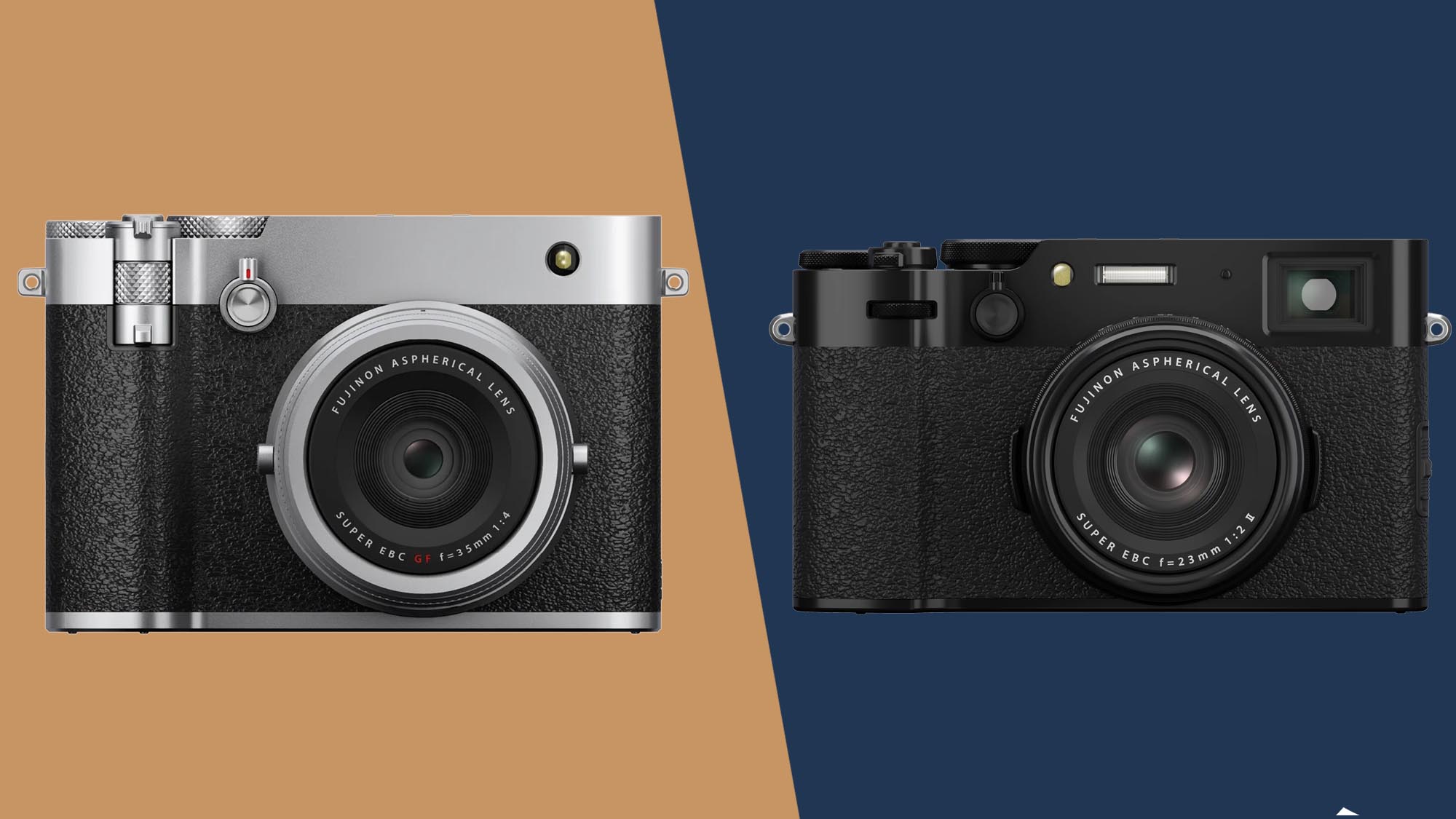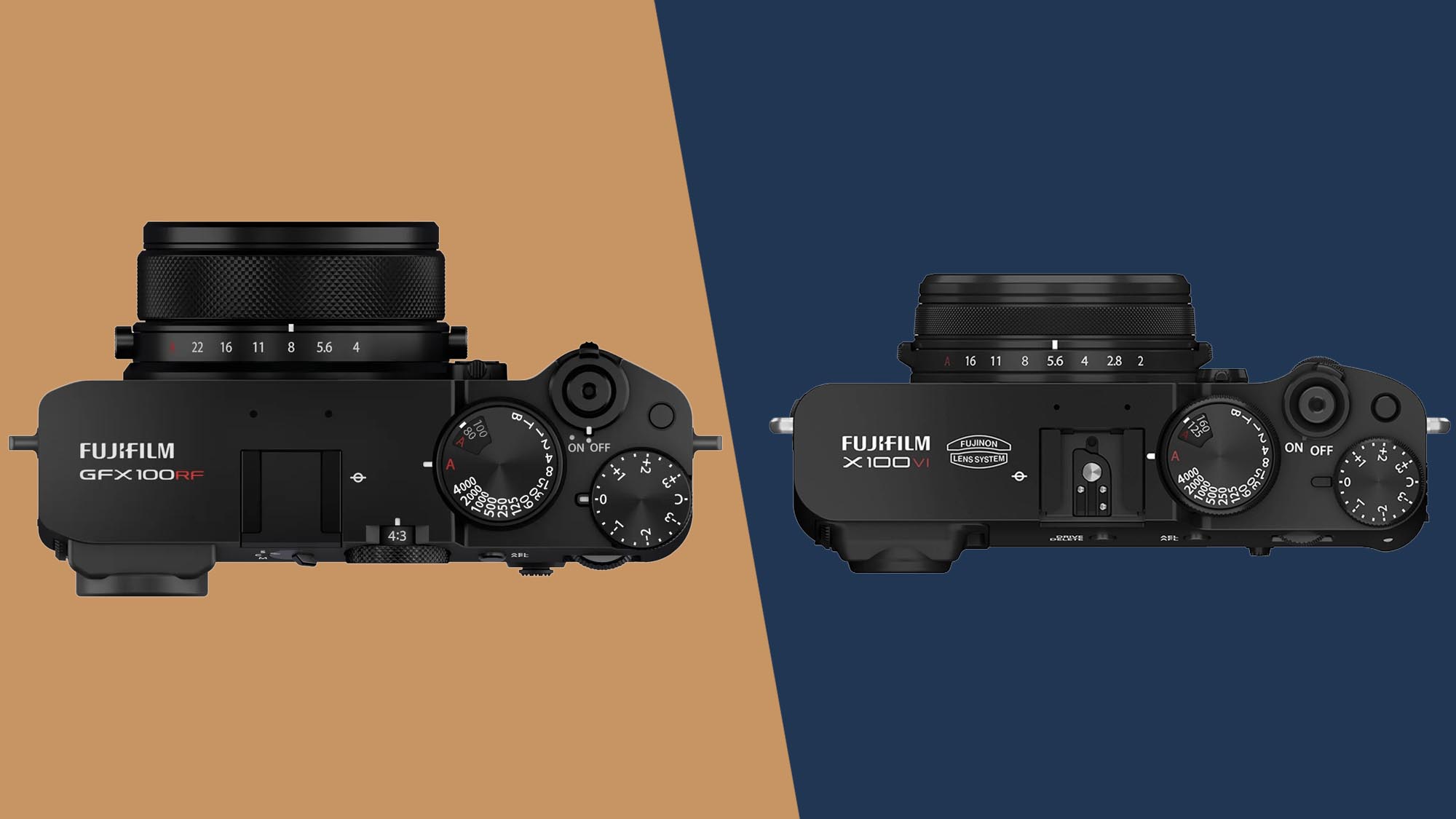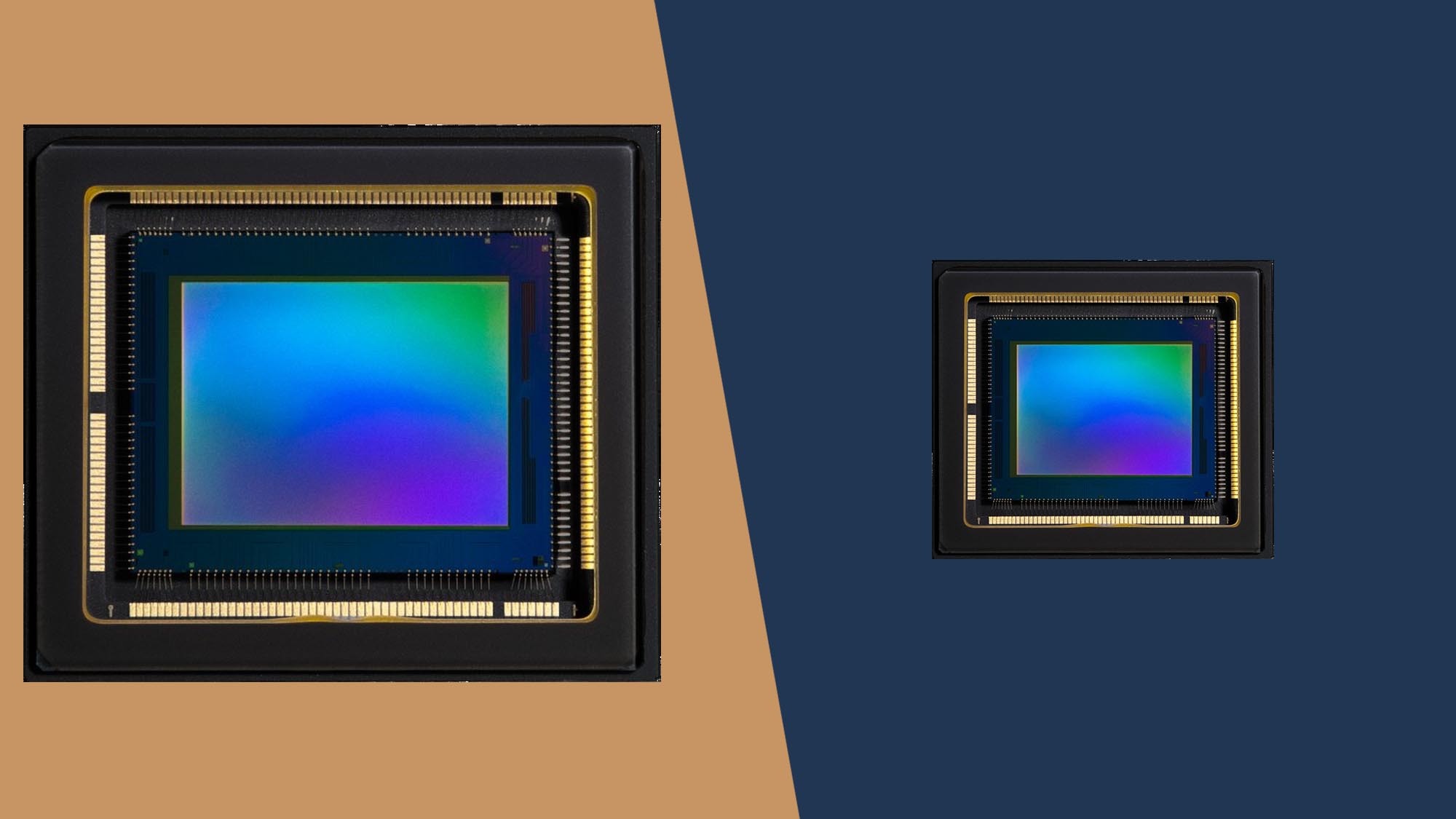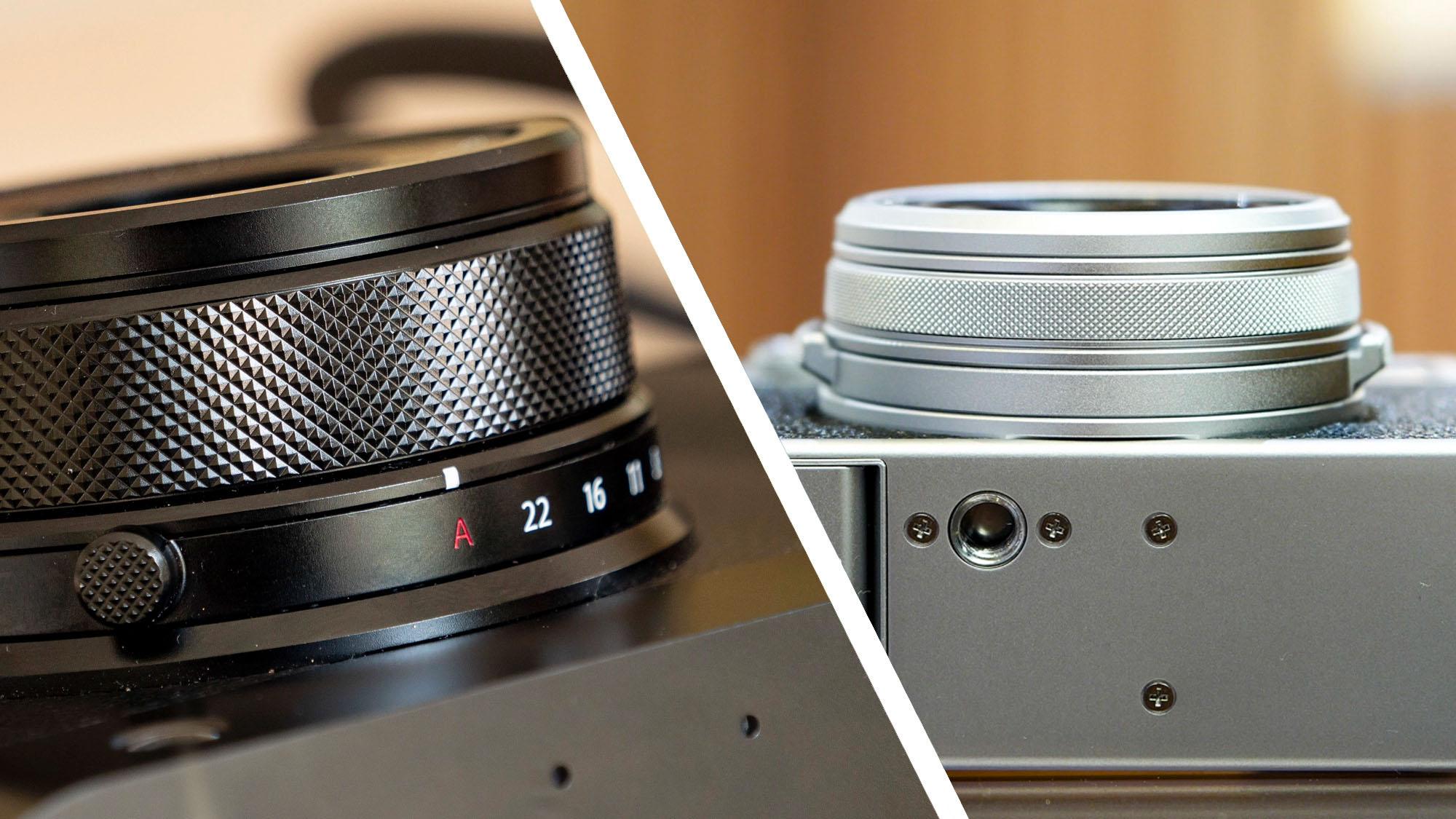Fujifilm GFX100RF vs Fujifilm X100VI: can an APS-C camera topple a medium-format model?
They're similar in size, but these two cameras require different approaches to creativity

Fujifilm brings medium-format camera tech to a new audience with the surprisingly compact X100RF.
Fujifilm's X100VI is a great all-purpose stills camera with top image quality and 6-stop IBIS.
Comparing cameras from completely different categories can often seem pointless, but the medium-format Fujifilm GFX100RF regularly draws comparisons to fellow TechRadar favourite the Fujifilm X100VI, which has a much smaller APS-C sensor.
Both cameras are ideal for use as walkaround travel or city cameras thanks to their fixed, relatively wide-angle lenses and compact bodies.
They're both 4.5/5 TechRadar-rated cameras too – but which is going to be better for you?
With a pricier medium-format sensor, the Fujifilm GFX100RF is, not surprisingly, a good deal more expensive than the Fujifilm X100VI, but that doesn't necessarily mean it's the better camera for everyone. While the GFX100RF has that desirably gigantic sensor, the X100VI is in several ways a more forgiving partner that's less likely to see you missing a shot at the crucial moment.
1. Price and availability

- The Fujifilm GFX100RF costs $4,899 / £4,699 / AU$8,799
- The Fujifilm X100VI costs $1,599 / £1,599 / AU$2,899
Fujifilm announced the GFX100RF in March 2025, ahead of an April release. It costs $4,899 / £4,699 / AU$8,799. This camera may make medium-format sensors seem more portable than before, but it doesn’t make them affordable for a wide audience.
The Fujifilm X100VI is a snip by comparison. It came out in February 2024, priced at $1,599 / £1,599 / AU$2,899. However, since then US orders have been suspended following tariff uncertainty, and there's speculation that its price could rise in the US.
2. Design

- Fujifilm GFX100RF: 133.5 x 90.4x 76.5mm, 735g
- Fujifilm X100VI: 128 x 74.8 x 55.3mm, 521g
The GFX100 RF and X100VI share the Fujifilm retro style, both being available in two-tone silver and black or all-black versions.
Sign up for breaking news, reviews, opinion, top tech deals, and more.
The X100VI is clearly closer to the norm of the classic Fujifilm blueprint, though. The GFX100 RF is taller and, to eyes that have looked upon this series for more than a decade, will appear perhaps even a little unusual.
That's because the Fujifilm GFX100 RF has a whole lot of sensor to fit into a camera that isn’t that big. It measures 133.5 x 90.4x 76.5mm, and weighs 735g with battery and memory card.
While this is substantially larger than the 128 x 74.8 x 55.3mm and 521g Fujifilm X100VI, the bigger camera is still relatively compact considering its sensor is two classes larger.
Neither camera is fully weather-sealed out of the box – that requires an additional lens adaptor ring and filter. The kit adds bulk to both cameras and isn't cheap, but you can find cheaper unofficial alternatives online.
3. Sensor and lens specs

- Fujifilm GFX100RF: medium-format (43.8 x 32.9mm), 35mm f/4 (28mm equivalent)
- Fujifilm X100VI: APS-C (23.5 x 15.7mm), 23mm f/2 (35mm equivalent)
The Fujifilm X100 series has always used APS-C sensors. The GFX100 RF has a medium-format sensor, the size class above full frame.
Its sensor chip is getting on for twice the size in length and height of the X100VI's at 43.8 x 32.9mm, resulting in almost four times the sensor area compared to APS-C. Despite a huge disparity in sensor resolution – 100MP against 40MP for the X100VI, the Fujifilm GFX100RF still has larger sensor pixels.
Their sensor shapes, their aspect ratios, are different too. Where the Fujifilm X100VI is a standard 3:2 design, the medium format sensor is a taller 4:3, providing greater lateral headroom.
Both cameras offer the option to shoot in either aspect ratio, applying a crop.
The lenses of these cameras are also quite different. Once we’ve translated their focal lengths to the 35mm standard, the GFX100RF comes out a little wider at 28mm compared to the the X100VI’s 35mm.
These are fixed-lens cameras, so the view on offer does bear thinking about properly. Which focal length are you going to get on with better?
And thanks to their sensor size there’s a predictable difference in maximum aperture, in order to keep the phyiscal dimensions of each lens sensibly compact. The Fujifilm GFX1000RF has what to some will sound a disappointing max of f/4, whereas the X100VI with its smaller sensor can open up to f/2.
The lenses also both have an aperture and a control/focus ring. Both cameras also have a built-in 4EV neutral density filter.
The question of which of these combos will net you better images does not have a simple answer.
4. Image Quality

- Fujifilm GFX100RF: large sensor, narrower aperture, no IBIS
- Fujifilm X100VI: effective IBIS, better for handheld use
Conventional wisdom suggests a camera with a larger sensor is going to excel in poor lighting, where such differences can largely even out in daylight. Real-world shooting with the Fujifilm GFX1000RF and X100VI tells a different story, though.
We’d pick up the X100VI for a night shoot in the city every time, and not just because it has that much wider maximum aperture. It also has sensor-based IBIS, which Fujifilm rates at six stops of effectiveness.
You’re going to have far greater scope to play with shutter speed when shooting handheld compared to the GFX100RF, which has no stabilization system at all.
Conversely, the medium-format Fujifilm GFX100RF is going to shine in controlled conditions, when using a tripod for example, or when there’s plenty of light. Such scenes will let the greater resolution of the medium format camera to come to the fore, and claim the advantage.
You're also going to be able to crop into the GFX100RF's images without obvious compromise much more so than with the X100VI, thanks to its ultra-high 100MP resolution. And its lens delivers edge-to-edge sharpness, even when shooting wide open at f/4.
For all-round flexibility though, the Fujifilm X100VI is going to be the winner for many, and it would make a terrific travel and holiday camera.
The X100VI can also focus closer than the GFX100RF too, with a minimum focus distance of 10cm versus 20cm. Can that difference be made up with a judicious crop? Sure, but if you're planning on trying macro photography (which neither camera is made for) we think the X100VI is likely to feel better as you actually shoot, thanks to that closer-focusing ability.
5. Modes and AF

- Fujifilm GFX100RF: 6fps burst, min 12 frame buffer
- Fujifilm X100VI: 20fps burst (6fps mechanical), min 17 frame buffer
As we’ve seen in previous medium-format cameras, larger sensors can often come with compromises attached, especially when it comes to speed.
The Fujifilm GFX100RF and X100VI have the same X-Processor 5 brains, but the APS-C camera has a much faster maximum burst speed, at 20fps when using a 1.29x crop or 13fps at full frame width. 6fps is the limit when using the mechanical shutter.
The GFX100RF has the same 6fps speed ceiling, again using the mechanical shutter, regardless of mode. Switching to the electronic shutter mode doesn’t help, as its top speed there is just 3fps.
Neither of these cameras is really made for ultra-fast sports-style photography, and that shows in their buffer limits. Shoot in uncompressed Raw + JPEG mode and you’ll only get 12 frames from the GFX100RF before the buffer needs to clear, or 17 from the X100VI.
5. Video

- Fujifilm GFX100RF: 4K/30fps, 1080p/60fps, 4:2:2 with ProRes
- Fujifilm X100VI: 6K/30fps, 4K/60fps, 1080p/240fps, 4:2:2 with H.265
At a glance the Fujifilm X100VI is the more capable of these two cameras for video. Despite having a much higher-resolution sensor, the top capture mode of the GFX100RF is lower.
It can shoot at up to 4K resolution, at 30 frames per second. The X100VI can reach 6K, at 30fps, using nearly the entire horizontal resolution of the sensor, with a 1.23x crop. Or, more useful to many, 4K recording at 60fps is also an option. This may net you slightly lesser image quality than the 'HQ' 4K/30 mode, though.
Both cameras can shoot using 4:2:2 color sampling, at 10-bit. But the Fujifilm GFX100RF does have one skill the X100VI lacks. It can record using Apple’s ProRes format, at bit rates far higher than the 200Mbps the Fujifilm X100VI uses with its H.265-based compression. You can’t record ProRes using an SD card, though; an SSD needs to be connected using the camera’s USB-C port.
The Fujifilm X100VI’s closest alternative to that is capturing footage over HDMI using an external recorder – more expensive than an external SSD, but still a viable option.
It also has far better slow-mo capabilities than the GFX100RF, on which the top frame rate is 60fps at 1080p. The X100VI can reach 240fps at 1080p, for an 8/10x slow-mo effect depending on your output frame rate.
6. EVF, screen and features
- Fujifilm GFX100RF: 5.76M dot EVF, 2.1M dot tilt screen
- Fujifilm X100VI: 3.69M dot hybrid EVF, 1.62M dot tilt screen

The Fujifilm GFX100RF is massively more expensive than the X100VI, and accordingly it uses higher-spec EVF and display tech. However, it also loses out on a signature Fujifilm feature.
In 2011, Fujifilm gave us the first hybrid viewfinder on the X100. The X100VI still has one, and is able to switch between optical and EVF views, while the GFX100RF has a more conventional EVF.
It has superior resolution, though, at 5.76m dots to 3.69m, and higher magnification, at 0.84x to 0.66x. The fact that it's not a hybrid design might be seen as a side-effect of Fujifilm’s space-saving, although earlier medium-format Fujifilms like the GFX 100S II didn’t have a hybrid viewfinder either. Beloved as they are among some camera circles, hybrid EVFs aren't for every camera range.
The GFX100RF has a slightly larger rear screen too, a 3.15-inch LCD with a 2.1 million-dot resolution. The X100VI’s is a humbler 1.62 million-dot 3-inch LCD. Both have tilt hinges and touchscreens.
What else is there to note? The Fujifilm GFX100RF has two 3.5mm ports, for headphones (for monitoring) and for a mic/remote input. The X100VI has a 2.5mm port for a microphone/remote, and if you want to monitor the audio you use the USB port with an adapter if necessary.
7. Battery life

- The Fujifilm GFX100RF is rated for over 800 shots
- The Fujifilm X100VI’s smaller battery manages 450 shots
The Fujifilm GFX100RF has a much higher capacity battery than the X100VI. It uses the 16Wh NP-W235, while the smaller camera has a 8.7Wh NP-W126S.
Sure enough, there’s a major disparity in their claimed shot counts per charge. Fujifilm says the GFX100RF can shoot for 820 frames, which is even higher than the 600 shots of the Fujifilm X-T4, which uses the same battery. The Fujifilm X100VI is rated for a more modest 450 frames.
Their video battery life is rated at 100 minutes and 45 minutes respectively, in the 4K capture mode.
There are no official battery grip accessories for these cameras. While Fujifilm has made them for the interchangeable-lens GFX models, compact portability is the aim here.
Early verdict

The Fujifilm GFX100RF and FujifilmX100VI are both great cameras that earned glowing reviews from our team. Fujifilm paints a picture of buyers using either as a stylish, all-purpose camera for travel, city use and so on.
You don’t need to dig in too far to find ways the Fujifilm X100VI is the better place to start for the majority of photographers, though.
It’s smaller and lighter, for one. A wider maximum aperture and sensor stabilization also makes up for the difference in sensor size in many situations, and provides greater shutter speed versatility when shooting handheld.
The GFX100RF comes to the fore when you change your shooting style to take into account the extent to which you can crop into the image and still get a usable picture. Fujifilm also deserves props for making medium format photography near-pocketable, although actually shooting with the camera may not feel as notable an upgrade over the X100VI as you might assume.
You might also like

Andrew is a freelance journalist and has been writing and editing for some of the UK's top tech and lifestyle publications including TrustedReviews, Stuff, T3, TechRadar, Lifehacker and others.
You must confirm your public display name before commenting
Please logout and then login again, you will then be prompted to enter your display name.